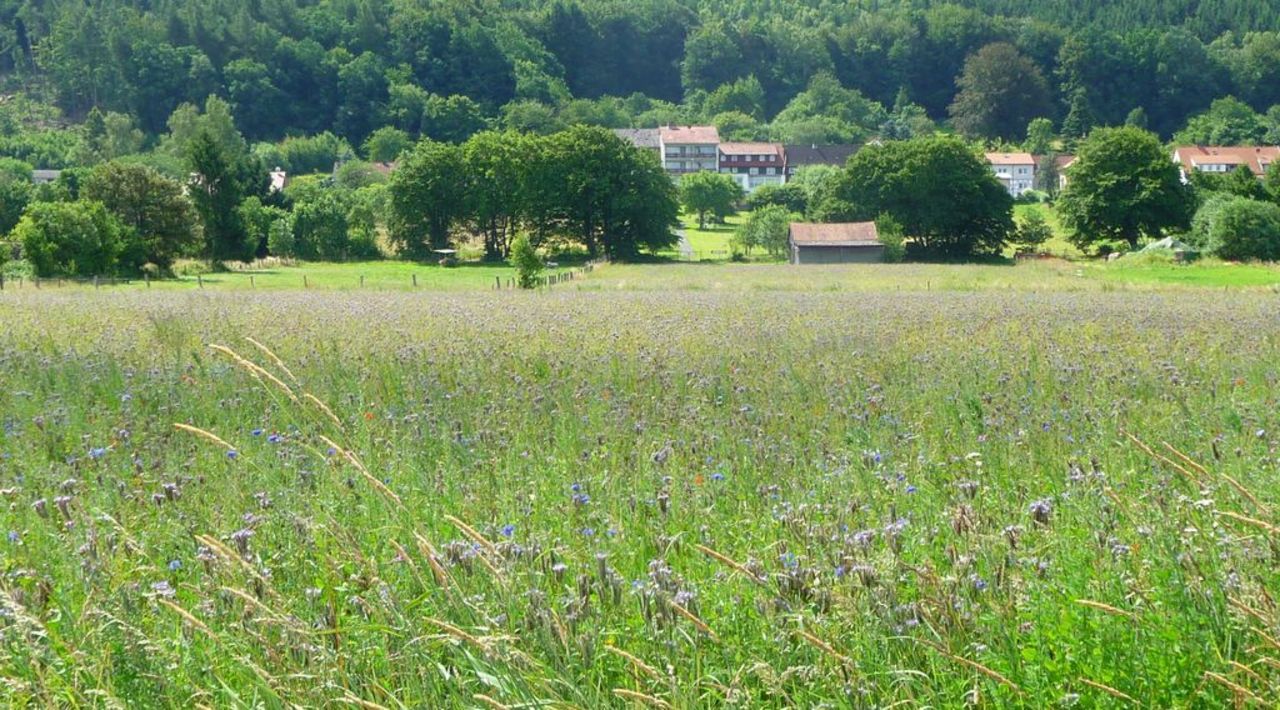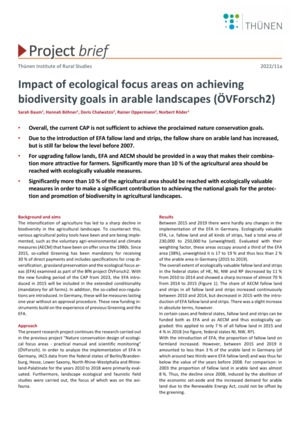Project
Impact of Ecological Focus Areas on achieving biodiversity goals in arable landscapes (OEVForsch2)

Biodiversity in agricultural landscapes is experiencing significant decline. To counteract this, since 2015 some of the direct payments under EU agricultural policy have been subject to “Greening requirements”. Most farms with more than 15 hectares of arable land must use 5% of their arable land for environmental conservation and dedicate it as an Ecological Focus Area. Based on the results of the first OEVForsch project (2015-2016), this project OEVForsch2 investigated the implementation and effectiveness of Ecological Focus Areas in the German agricultural landscape.
Background and Objective
In the agricultural landscape, strong declines in species and persistently high nutrient inputs into soils and water bodies are observed. In order to protect the environment and to meet European and global requirements for the protection of biodiversity, one of the goals of the EU Commission, with the latest reform of the Common Agricultural Policy (CAP) was to establish a more environmentally friendly first pillar (direct payments to farmers). Up to then the voluntary agri-environmental measures, financed under the second pillar of the CAP, were applied relatively rarely in intensively used agricultural regions.
For this reason, most farms with more than 15 hectares of arable land have been obligated, since 2015, to designate 5% as Ecological Focus Areas (EFA). EU member states can select different types of EFA from a list drawn up by the EU for the national implementation. EFAs range from those that permit usage of the land (e.g., for nitrogen-fixing plants) to those on which no use is permitted (e.g., fallow land). In order to allow German farmers a high degree of flexibility, a large number of land use types can be designated as EFA.
The ecological effectiveness of the new regulation and the proportionality of the administrative and control costs are currently being discussed. Initial findings on the ecological effectiveness of EFA showed that a large proportion of high-quality EFA (fallow land and stripes) were already present in farms, and that these EFA are more likely to be reported by large farms. As a result, species that are native to bushes and ruderal areas (e.g., whitethroat, marsh warbler, goldfinch) are benefiting, but not those that colonize the open agricultural landscape (e.g., skylark, yellow wagtail). The positive benefits of EFA for biodiversity depend not only on the type, but also on factors such as specific location, size, cultivation or care, adjacent areas and interconnectedness.
Target Group
Agricultural and Environmental Ministries; Farmers; Consultancy; Official Nature Conservation; Agricultural Administration, EU Commission
Approach
IACS data of the federal states on land use and operational indicators were analyzed with regard to:
- the implementation and acceptance by farmers with regard to the different greening options over time and possible operational and local reasons for this;
- a professional nature conservation assessment of the greening options based on their spatial location (area size, type of management, site characteristics, period of non-use, spatial context);
- the development and understanding of how changes in the population of field birds are related to changes in agricultural land use.
Once the results gained have been assessed and discussed, they will be compiled into a report with policy recommendations. The report will focus on the ecological effectiveness of EFA, cost efficiency, administrative expense and the importance of accompanying instruments (consulting, agri-environmental measures).
Data and Methods
The implementation of EFA and their effectiveness in the German agricultural landscape will be investigated and monitored with the help of IACS data.
Within the framework of this project, the Institute for Agro-ecology and Biodiversity focuses on empirical ecological field research.
Our Research Questions
Does the provision of “Greening areas” change over time? How do farmers react to economic and natural conditions?
To what extent does a conversion from grassland to arable land take place in order to meet other greening requirements?
Has the acceptance of the combination of greening measures with agri-environmental and climate measures (AACM) increased?
How spatially stable are especially high-quality Ecological Focus Areas over time?
How is the spatial embedding of Ecological Focus Areas to be evaluated and how is the distribution?
What impact will the changes in greening resolved have on farmers’ professional decisions?
Is it possible to derive the effects of “Greening” from the German breeding bird monitoring?
Results
The data analysis and field observations have shown that from an environmental point of view there have been some improvements from the EFA Greening schemes, but only to a very limited extent. Based on the results, we recommend the following for EU agricultural policy:
- In order to achieve more for biodiversity in the agricultural landscape, exemptions of farms from the greening obligations transferred to the extended conditionality from 2023 should be limited.
- Efforts should be made to establish ecologically valuable measures (off-crop and in-crop) on well over 10 % of agricultural land.
- The EFA measures (or comparable successors) must be more demanding: ecologically less valuable measures should be deleted, others modified (e. g. no use of pesticides, promotion of flowering mixtures). Pure deadweight effects should be avoided and payments made based on performance.
- Ecologically valuable EFA (or comparable successors) must also be attractive in intensive regions in order to counteract high pressures on biodiversity there.
- EFAs (or comparable successors) are to be exempted from the five-year regulation in order to allow longer periods for fallow land and strips without the arable land becoming permanent grassland. A cut-off date regulation would be more suitable, according to which existing permanent grassland would be subject to the maintenance regulation, but new land created after the cut-off date would not.
- In addition to unproductive measures, ecologically senseful productive measures such as the cultivation of grain with an extended sowing distance or light grain should be promoted more strongly.
- It should be more attractive to combine EFA (or comparable successors) and AECM in order to further upgrade existing areas.
- Offers of advice and information are important in order to increase the effect of the individual measures.
- Clear targets must be defined for the EFA measures (or comparable successors).
The scope and quality of the measures are the decisive characteristics for making a positive contribution to biodiversity in the agricultural landscape. Accordingly, it is essential to provide incentives for the large-scale implementation of high-quality measures.
A brief summary of the core findings can be found in the Project Brief.
Links and Downloads
Thünen-Contact

Involved Thünen-Partners
Involved external Thünen-Partners
- Institut für Agrarökologie und Biodiversität (ifab)
(Mannheim, Deutschland)
Funding Body
-
Federal Agency for Nature Conservation (BfN)
(national, öffentlich)
Duration
8.2017 - 12.2020
More Information
Project funding number: FKZ 3517 84 0200
Funding program: BMUB - Umweltforschungsplan
Project status:
finished
Publications to the project
- 0
Baum S, Böhner HGS, Chalwatzis D, Oppermann R, Röder N (2022) Impact of ecological focus areas on achieving biodiversity goals in arable landscapes (ÖVForsch2). Braunschweig: Thünen Institute of Rural Studies, 2 p, Project Brief Thünen Inst 2022/11a, DOI:10.3220/PB1658730721000
- 1
Baum S, Böhner HGS, Chalwatzis D, Oppermann R, Röder N (2022) Wirkung ökologischer Vorrangflächen zur Erreichung der Biodiversitätsziele in Ackerlandschaften (ÖVForsch2). Braunschweig: Thünen-Institut für Lebensverhältnisse in ländlichen Räumen, 2 p, Project Brief Thünen Inst 2022/11, DOI:10.3220/PB1647852937000
- 2
Baum S, Chalwatzis D, Böhner HGS, Oppermann R, Röder N (2022) Wirkung ökologischer Vorrangflächen zur Erreichung der Biodiversitätsziele in Ackerlandschaften : Endbericht zum gleichnamigen Forschungsvorhaben, 2017 bis 2021 (FKZ: 3517 840 200). Bonn: BfN, 335 p, BfN Skripten 630, DOI:10.19217/skr630
- 3
Baum S, Böhner HGS, Röder N (2021) What are we talking about? Patterns in the implementation of wildflower strips and fallows by German farmers. Verhandl Gesellsch Ökol 50: 314
- 4
Pe'er G, Bonn A, Bruelheide H, Dieker P, Eisenhauer N, Feindt PH, Hagedorn G, Hansjürgens B, Herzon I, Lomba A, Marquard E, Moreira F, Nitsch H, Oppermann R, Perino A, Röder N, Schleyer C, Schindler S, Wolf C, Zinngrebe Y, Lakner S (2020) Action needed for the EU Common Agricultural Policy to address sustainability challenges. People Nature 2(2):305-316, DOI:10.1002/pan3.10080
- 5
Oppermann R, Chalwatzis D, Röder N, Baum S (2020) Biodiversität in der Gemeinsamen Agrarpolitik (GAP) der EU nach 2020 : Ergebnisse und Empfehlungen aus den Forschungs- und Entwicklungsvorhaben "Naturschutzfachliche Ausgestaltung von ökologischen Vorrangflächen" (OEVForsch I; 2015 - 2017) und "Wirkung ökologischer Vorrangflächen zur Erreichung der Biodiversitätsziele in Ackerlandschaften" (OEVForsch II; 2017 - 2020) [online]. Bonn: BfN, 11 p, zu finden in <https://www.bfn.de/fileadmin/BfN/landwirtschaft/Dokumente/Broschu__re-Biodiversitaet_in_der_Gemeinsamen_Agrarpolitik__GAP__der_EU_nach_2020.pdf> [zitiert am 18.08.2020]
- 6
Röder N, Ackermann A, Baum S, Böhner HGS, Rudolph S, Schmidt TG (2019) Small is beautiful? Is there a relation between farmed area and the ecological output? - Results from evaluation studies in Germany : paper prepared for presentation at the 172nd EAAE Seminar "Agricultural Policy for the Environment or Environmental Policy for Agriculture?" ; May 28-29, 2019, Brussels. 15 p

![[Translate to English:] [Translate to English:]](/media/_processed_/2/0/csm_LV_Bei_Hornburg_Quelle_Johanna_Fick_neu_da89674833.jpg)
![[Translate to English:] [Translate to English:]](/media/_processed_/2/0/csm_LV_Bei_Hornburg_Quelle_Johanna_Fick_neu_3aae309567.jpg)

![[Translate to English:] Logo des Bundesministerium für Ernährung und Landwirtschaft](/media/allgemein/logos/BMEL_Logo.svg)